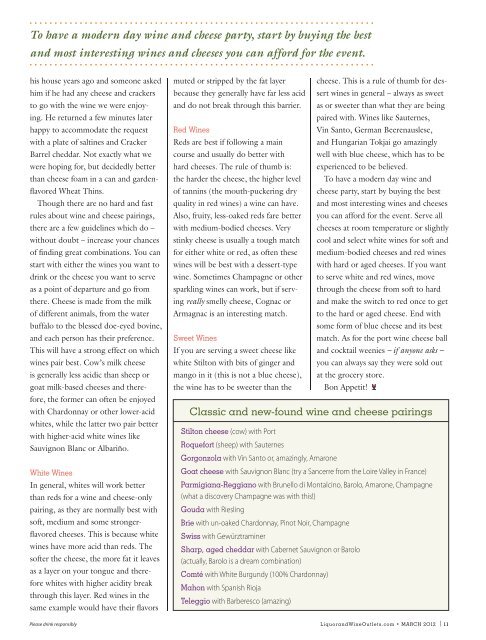Canadian Whisky - BlueToad
Canadian Whisky - BlueToad
Canadian Whisky - BlueToad
You also want an ePaper? Increase the reach of your titles
YUMPU automatically turns print PDFs into web optimized ePapers that Google loves.
To have a modern day wine and cheese party, start by buying the best<br />
and most interesting wines and cheeses you can afford for the event.<br />
his house years ago and someone asked<br />
him if he had any cheese and crackers<br />
to go with the wine we were enjoying.<br />
He returned a few minutes later<br />
happy to accommodate the request<br />
with a plate of saltines and Cracker<br />
Barrel cheddar. Not exactly what we<br />
were hoping for, but decidedly better<br />
than cheese foam in a can and gardenflavored<br />
Wheat Thins.<br />
Though there are no hard and fast<br />
rules about wine and cheese pairings,<br />
there are a few guidelines which do –<br />
without doubt – increase your chances<br />
of finding great combinations. You can<br />
start with either the wines you want to<br />
drink or the cheese you want to serve<br />
as a point of departure and go from<br />
there. Cheese is made from the milk<br />
of different animals, from the water<br />
buffalo to the blessed doe-eyed bovine,<br />
and each person has their preference.<br />
This will have a strong effect on which<br />
wines pair best. Cow’s milk cheese<br />
is generally less acidic than sheep or<br />
goat milk-based cheeses and therefore,<br />
the former can often be enjoyed<br />
with Chardonnay or other lower-acid<br />
whites, while the latter two pair better<br />
with higher-acid white wines like<br />
Sauvignon Blanc or Albariño.<br />
White Wines<br />
In general, whites will work better<br />
than reds for a wine and cheese-only<br />
pairing, as they are normally best with<br />
soft, medium and some strongerflavored<br />
cheeses. This is because white<br />
wines have more acid than reds. The<br />
softer the cheese, the more fat it leaves<br />
as a layer on your tongue and therefore<br />
whites with higher acidity break<br />
through this layer. Red wines in the<br />
same example would have their flavors<br />
muted or stripped by the fat layer<br />
because they generally have far less acid<br />
and do not break through this barrier.<br />
red Wines<br />
Reds are best if following a main<br />
course and usually do better with<br />
hard cheeses. The rule of thumb is:<br />
the harder the cheese, the higher level<br />
of tannins (the mouth-puckering dry<br />
quality in red wines) a wine can have.<br />
Also, fruity, less-oaked reds fare better<br />
with medium-bodied cheeses. Very<br />
stinky cheese is usually a tough match<br />
for either white or red, as often these<br />
wines will be best with a dessert-type<br />
wine. Sometimes Champagne or other<br />
sparkling wines can work, but if serving<br />
really smelly cheese, Cognac or<br />
Armagnac is an interesting match.<br />
Sweet Wines<br />
If you are serving a sweet cheese like<br />
white Stilton with bits of ginger and<br />
mango in it (this is not a blue cheese),<br />
the wine has to be sweeter than the<br />
cheese. This is a rule of thumb for dessert<br />
wines in general – always as sweet<br />
as or sweeter than what they are being<br />
paired with. Wines like Sauternes,<br />
Vin Santo, German Beerenauslese,<br />
and Hungarian Tokjai go amazingly<br />
well with blue cheese, which has to be<br />
experienced to be believed.<br />
To have a modern day wine and<br />
cheese party, start by buying the best<br />
and most interesting wines and cheeses<br />
you can afford for the event. Serve all<br />
cheeses at room temperature or slightly<br />
cool and select white wines for soft and<br />
medium-bodied cheeses and red wines<br />
with hard or aged cheeses. If you want<br />
to serve white and red wines, move<br />
through the cheese from soft to hard<br />
and make the switch to red once to get<br />
to the hard or aged cheese. End with<br />
some form of blue cheese and its best<br />
match. As for the port wine cheese ball<br />
and cocktail weenies – if anyone asks –<br />
you can always say they were sold out<br />
at the grocery store.<br />
Bon Appetit!<br />
classic and new-found wine and cheese pairings<br />
Stilton cheese (cow) with Port<br />
roquefort (sheep) with Sauternes<br />
Gorgonzola with Vin Santo or, amazingly, Amarone<br />
Goat cheese with Sauvignon Blanc (try a Sancerre from the Loire Valley in France)<br />
Parmigiana-reggiano with Brunello di Montalcino, Barolo, Amarone, Champagne<br />
(what a discovery Champagne was with this!)<br />
Gouda with Riesling<br />
Brie with un-oaked Chardonnay, Pinot Noir, Champagne<br />
Swiss with Gewürztraminer<br />
Sharp, aged cheddar with Cabernet Sauvignon or Barolo<br />
(actually, Barolo is a dream combination)<br />
comté with White Burgundy (100% Chardonnay)<br />
mahon with Spanish Rioja<br />
Teleggio with Barberesco (amazing)<br />
Please drink responsibly LiquorandWineOutlets.com • march 2O12 | 11






